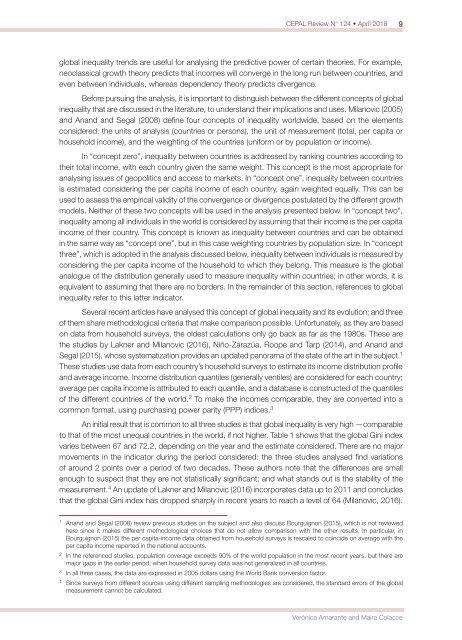CEPAL Review no. 124
April 2018
April 2018
You also want an ePaper? Increase the reach of your titles
YUMPU automatically turns print PDFs into web optimized ePapers that Google loves.
<strong>CEPAL</strong> <strong>Review</strong> N° <strong>124</strong> • April 2018<br />
9<br />
global inequality trends are useful for analysing the predictive power of certain theories. For example,<br />
neoclassical growth theory predicts that incomes will converge in the long run between countries, and<br />
even between individuals, whereas dependency theory predicts divergence.<br />
Before pursuing the analysis, it is important to distinguish between the different concepts of global<br />
inequality that are discussed in the literature, to understand their implications and uses. Mila<strong>no</strong>vic (2005)<br />
and Anand and Segal (2008) define four concepts of inequality worldwide, based on the elements<br />
considered: the units of analysis (countries or persons), the unit of measurement (total, per capita or<br />
household income), and the weighting of the countries (uniform or by population or income).<br />
In “concept zero”, inequality between countries is addressed by ranking countries according to<br />
their total income, with each country given the same weight. This concept is the most appropriate for<br />
analysing issues of geopolitics and access to markets. In “concept one”, inequality between countries<br />
is estimated considering the per capita income of each country, again weighted equally. This can be<br />
used to assess the empirical validity of the convergence or divergence postulated by the different growth<br />
models. Neither of these two concepts will be used in the analysis presented below. In “concept two”,<br />
inequality among all individuals in the world is considered by assuming that their income is the per capita<br />
income of their country. This concept is k<strong>no</strong>wn as inequality between countries and can be obtained<br />
in the same way as “concept one”, but in this case weighting countries by population size. In “concept<br />
three”, which is adopted in the analysis discussed below, inequality between individuals is measured by<br />
considering the per capita income of the household to which they belong. This measure is the global<br />
analogue of the distribution generally used to measure inequality within countries; in other words, it is<br />
equivalent to assuming that there are <strong>no</strong> borders. In the remainder of this section, references to global<br />
inequality refer to this latter indicator.<br />
Several recent articles have analysed this concept of global inequality and its evolution; and three<br />
of them share methodological criteria that make comparison possible. Unfortunately, as they are based<br />
on data from household surveys, the oldest calculations only go back as far as the 1980s. These are<br />
the studies by Lakner and Mila<strong>no</strong>vic (2016), Niño-Zarazúa, Roope and Tarp (2014), and Anand and<br />
Segal (2015), whose systematization provides an updated pa<strong>no</strong>rama of the state of the art in the subject. 1<br />
These studies use data from each country’s household surveys to estimate its income distribution profile<br />
and average income. Income distribution quantiles (generally ventiles) are considered for each country;<br />
average per capita income is attributed to each quantile, and a database is constructed of the quantiles<br />
of the different countries of the world. 2 To make the incomes comparable, they are converted into a<br />
common format, using purchasing power parity (PPP) indices. 3<br />
An initial result that is common to all three studies is that global inequality is very high —comparable<br />
to that of the most unequal countries in the world, if <strong>no</strong>t higher. Table 1 shows that the global Gini index<br />
varies between 67 and 72.2, depending on the year and the estimate considered. There are <strong>no</strong> major<br />
movements in the indicator during the period considered: the three studies analysed find variations<br />
of around 2 points over a period of two decades. These authors <strong>no</strong>te that the differences are small<br />
e<strong>no</strong>ugh to suspect that they are <strong>no</strong>t statistically significant; and what stands out is the stability of the<br />
measurement. 4 An update of Lakner and Mila<strong>no</strong>vic (2016) incorporates data up to 2011 and concludes<br />
that the global Gini index has dropped sharply in recent years to reach a level of 64 (Mila<strong>no</strong>vic, 2016).<br />
1<br />
Anand and Segal (2008) review previous studies on the subject and also discuss Bourguig<strong>no</strong>n (2015), which is <strong>no</strong>t reviewed<br />
here since it makes different methodological choices that do <strong>no</strong>t allow comparison with the other results. In particular, in<br />
Bourguig<strong>no</strong>n (2015) the per capita-income data obtained from household surveys is rescaled to coincide on average with the<br />
per capita income reported in the national accounts.<br />
2<br />
In the referenced studies, population coverage exceeds 90% of the world population in the most recent years, but there are<br />
major gaps in the earlier period, when household survey data was <strong>no</strong>t generalized in all countries.<br />
3<br />
In all three cases, the data are expressed in 2005 dollars using the World Bank conversion factor.<br />
4<br />
Since surveys from different sources using different sampling methodologies are considered, the standard errors of the global<br />
measurement can<strong>no</strong>t be calculated.<br />
Verónica Amarante and Maira Colacce


















